Contents
A Note on Sources
This is a biography of my paternal grandmother's brother, William Henry Charles Griffin.
- The vast majority of documentation of William's life and death comes from his AIF military file as well as military histories
of his battalion, regiment, and division.
- Some family oral history has passed down the generations.
- I have also added some hopefully informed thoughts.
Family oral histories are notoriously unreliable, so I've only included narratives I've heard from multiple family members, or
narratives that align with available documentation. If you are a family member with additional (possibly conflicting!) stories or
documents I'd be happy to hear from you. My email address is above.
Early years
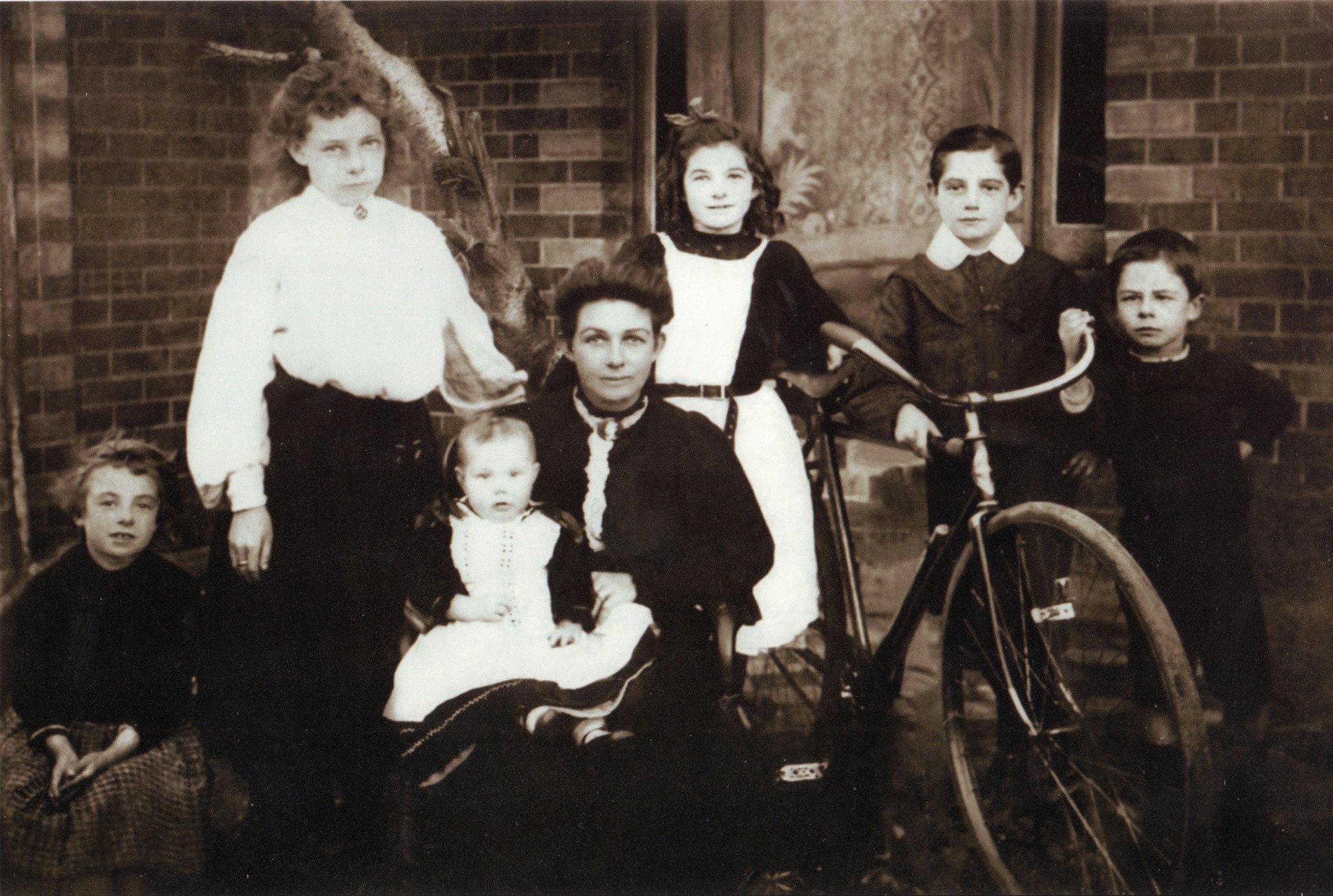
Griffin Family around 1910, likely taken at
23 Sheffield St, Coburg: (lr) Evelina, Daisy Violet Victoria, Valerie Amelia
(infant), Rachel Louisa Griffin (nee Cooper), Florence Ada, William Henry Charles, James Morris. Not pictured are William Sr (no
picture exists?), Lillian May (living away from home?), and Ivy May (born later).
William Henry Charles ("Will") Griffin was born 26 September 1898 in South Melbourne. His father, also William, was 48 years old on that day, his mother Rachel was 25. Will was the first-born son.
The family frequently moved addresses through Will's childhood and teen years. They are recorded as living in North Melbourne in
1906, Coburg in 1909, Brunswick in 1914, and Clifton Hill in 1915.[1]
Family oral history records that Will's father was a deeply religious man, that the family was very poor and
were frequently evicted for failure to pay the rent, and that Will's father likely struggled with mental illness.
Even though Will was the oldest of the Griffin sons, he did have an older brother figure in his life. Some time between 1909 and
1914 Rachel took in a young man by the name of George William Stap. George was born in 1890 and had experienced difficult childhood and
teen years. George's mother moved from Melbourne to Perth when George was very young, and George was reported as living in a charity
home in Perth when he was 7.[2] George's mother died in Fremantle in 1906 and he moved
back to South Melbourne shortly after. George's father, Charles Henry Stap, lived a few doors from the Griffin family in
South Melbourne during this time, but he was in poor health and died of pulmonary tuberculosis in 1915.
George enlisted in the Australian Imperial Force on 20 January 1915. He initially named his father as his next-of-kin, however when
his father died he nominated Rachel as his next-of-kin. He listed Rachel's relationship to him as foster-mother. He was assigned to the
8th Battalion and after training and transport, landed at Anzac Cove on 17 July 1915 to join the disastrous Gallipoli Campaign.[3]
After the Gallipoli evacuation in December 1915, the 8th Battalion was transferred to France. George was wounded several times and
returned to his unit. He also received additional machine gun training in England. On 10 January 1918 George was promoted to corporal,
and on 22 August 1918 he was promoted to sergeant.[3]
I suspect George was corresponding with Rachel and the rest of the Griffins during his deployments in Turkey
and France. As an important figure in the family, and as a much-lionized ANZAC, I believe George indirectly, but very strongly,
influenced William's desire to join the Australian Imperial Force (AIF).
Compulsory Universal Training
Family oral history doesn't offer any information about Will's childhood and teenage years though some can be gleaned from his later
military records. Will attended Clifton Hill School, and his trade was iron worker.
On 1 January 1911, the Commonwealth Defence Act was passed. It required all males aged 12 to 26 to receive military training. Men
were divided according to age, with junior cadets comprising boys 12-13 years of age, senior cadets comprising boys 14-17, and young
men aged 18-26 assigned to the home militia defence. Absenteeism and shirking were widespread. Many boys were brought before the
courts, including the Children's Court.
Will was not a shirker, he attended mandatory drills with the Collingwood Senior Cadets, 55A Battalion of the Citizens
Forces.[4] 55A was occasionally mentioned in the papers, providing drill demonstrations at public events around Collingwood.
First attempt to enlist
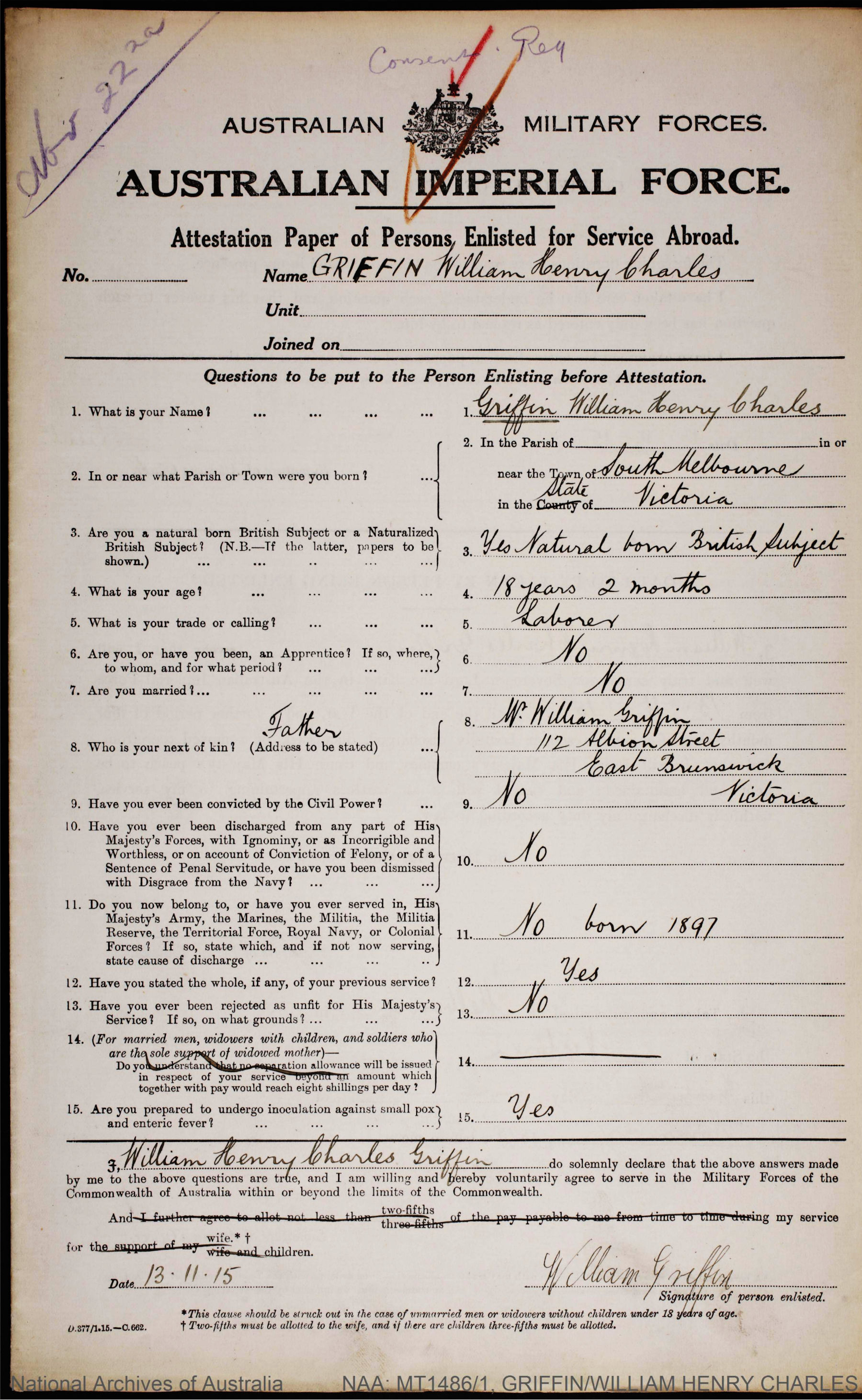
AIF record of W.H.C. Griffin's first attempt to enlist underage and without parental consent.
[6]
On 13 November 1915, at age 17 years, 1 month, 19 days, Will attempted to enlist in the AIF. The AIF required enlistees to be at least
age 18. All enlistees under the age of 21 were required to provide written consent from their parents. All enlistees also had to pass
the medical requirements.
Will passed the medical examination, however in purple pencil at the top of the form is the notation:
Nov 22nd Consent Req
Description on enlistment:
- Age 18 years 2 months.
- Height 5 feet 4 3⁄4 inches.
- Chest Measurement 32/34 inches.
- Complexion Fresh.
- Eyes Hazel
- Hair D. Brown
- Religious Denomination Pres.
- Distinctive Marks: Vac. Nil, Broken R. Arm badly knitted together.
Will was rejected because he did not provide the mandatory parental consent.[6]
Will lied about his age presumably to "get in the fight". The Gallipoli Campaign was underway, but the AIF
was trapped in a deadly stalemate. In late 1915 Australian newspapers were full of stories of what was clearly turning into a military
disaster. Many of these stories cast the fight as a gallant adventure and the ANZACs as stoic heroes.
Successful enlistment
On 25 August 1917, at age 18 years, 11 months, Will successfully enlisted. Will presented a letter purporting to give the mandatory
parental consent, passed the physical (again), and was assigned to the 23rd Battalion as part of the 20th Reinforcements.[4]
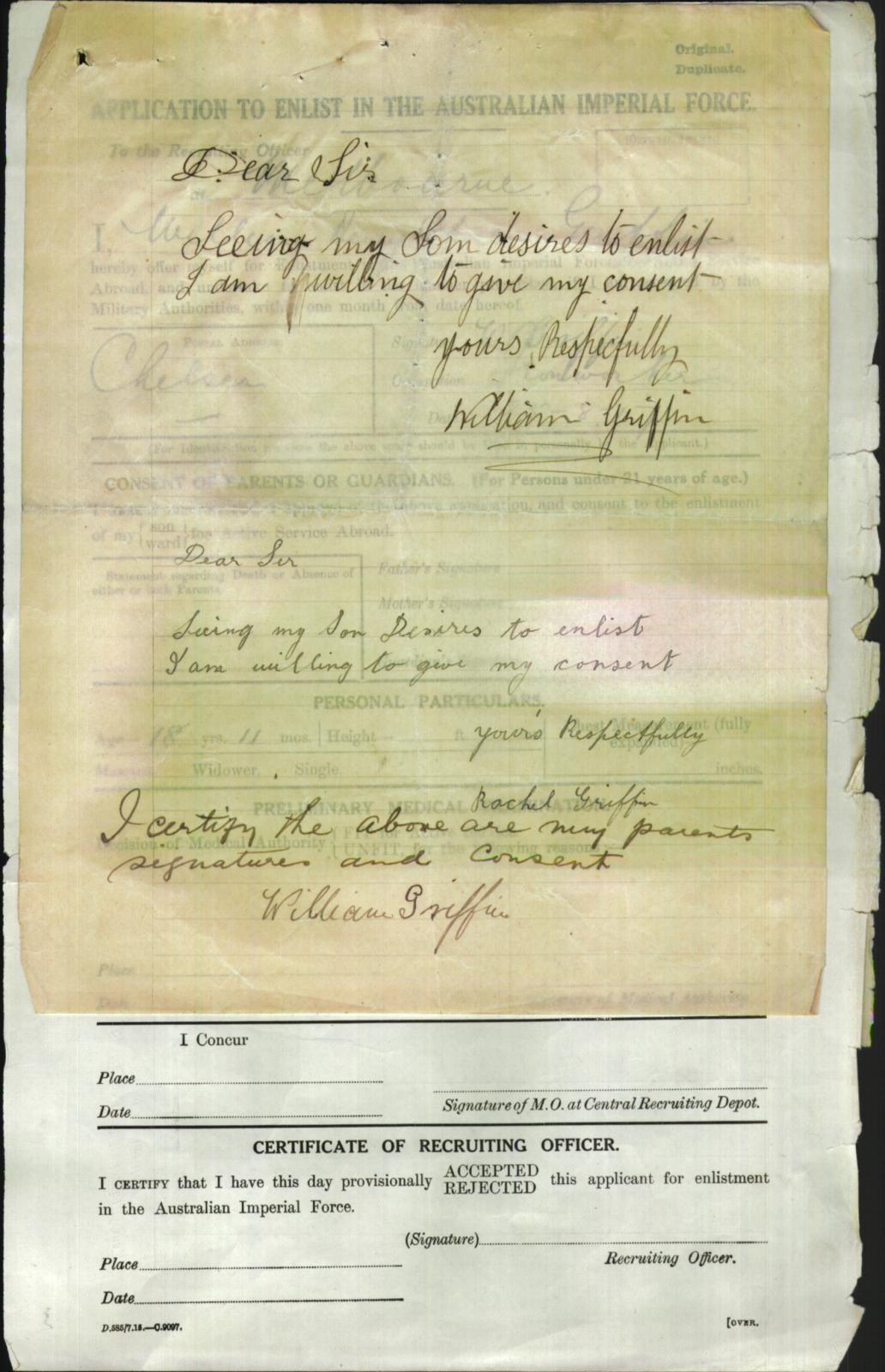
Parents' consent letter attached to W.H.C. Griffin's enlistment form. Rachel refused to give her consent, so that part of the
letter was written by Will's sister, Evelina. Evelina's granddaughter has confirmed that this is Evelina's handwriting.
Family oral history records that Will was unable to obtain his mother's consent to enlist. Will asked his
younger sister, Evelina, to write the consent letter and sign it with their mother's name. The consent letter is scanned as part of
Will's AIF record and is available at the National Archives of Australia. A family member has confirmed that the section of the consent
letter signed "Rachel Griffin" is in Evelina's handwriting.
Will's father's consent appears first. If Will had his sister's forged consent appear first his father would
have no doubt noticed his daughter's handwriting when giving his own consent.
Dear Sir
Seeing my Son desires to enlist
I am willing to give my consent
Yours Respectfully
William Griffin
Dear Sir
Seeing my Son Desires to enlist
I am willing to give my consent
Yours Respectfully
Rachel Griffin
I certify the above are my parents
signatures and consent
William Griffin
Given Will's previous attempt to enlist underage, I assume he would have wanted to enlist again exactly on his
18th birthday. The gap between his birthday and enlistment date is because he would have been attempting to persuade his mother,
Rachel, to give consent, and when that failed, he began pressuring one of his sisters.
By late 1917 Rachel had likely been informed of George's brushes with death in Turkey and France, through
both official notifications from the Australian Army, and from reading newspapers. This is most certainly why she refused to consent to
her son being exposed to those dangers.
Note that the consent letter above was scanned over the official enlistment form. That form required both
parents to be present at the enlistment to sign the form. If both parents could not be present then the recruit had to supply an
explanation for their absence. At the time of Will's enlistment the AIF was not able to recruit enough men to replace the enormous
number of Australian casualties in France, so AIF recruiters may have been cutting corners by allowing this letter with the explanation
section of the form left blank.
23rd Battalion, 20th Reinforcements
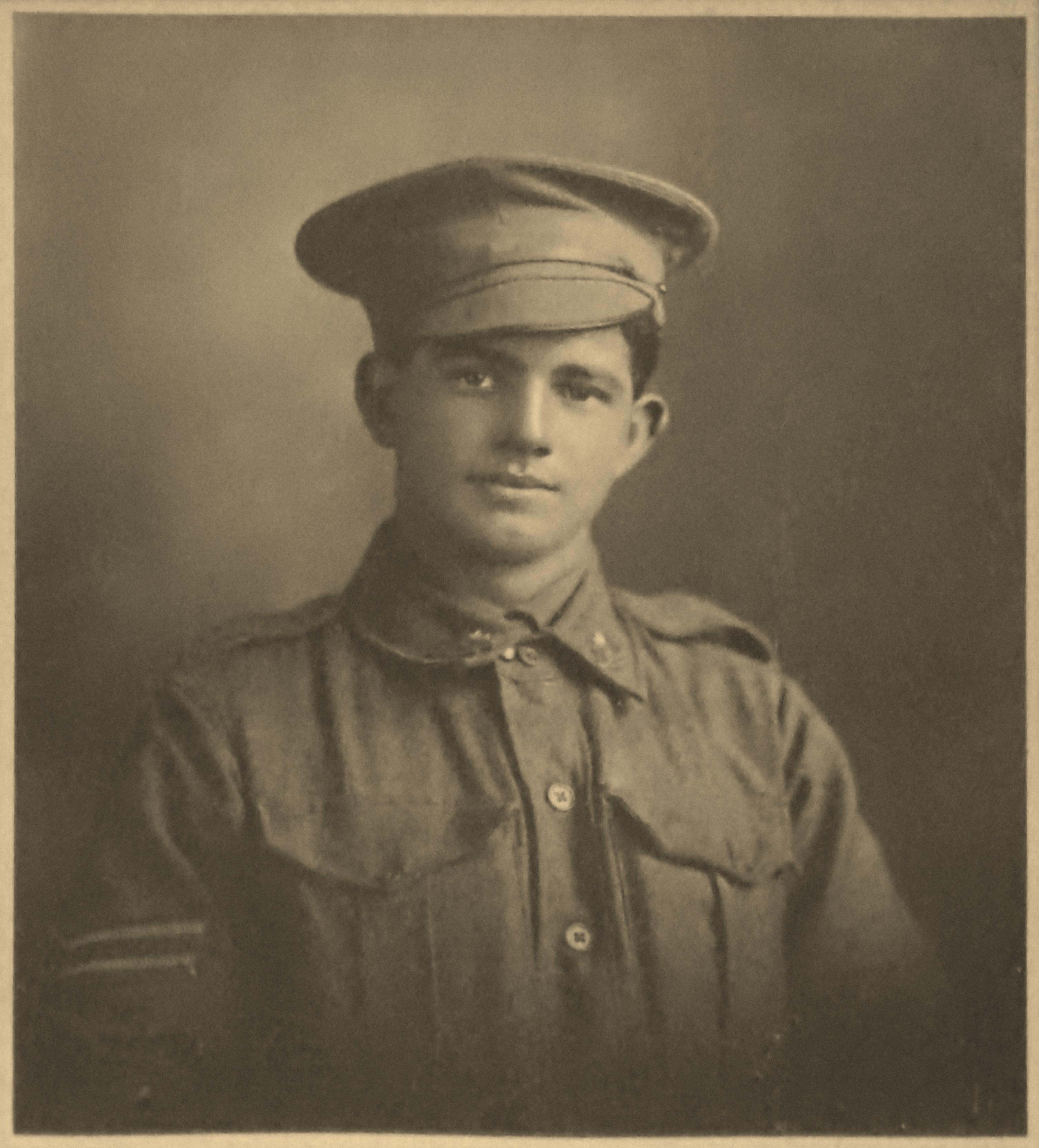
Acting Lance Corporal W.H.C. Griffin at Fovant, England, March 1918.
Will underwent brief training at the AIF camp in Broadmeadows and on 21 November 1917 embarked on the Nestor for Egypt. The
Nestor arrived in Egypt on 5 January 1918. Will had additional training at an Australian Army camp just outside Alexandria. From
there he embarked on the Abbessiah for England, disembarking at Southampton on 23 January 1918.[4]
In England Will had one last round of training at the AIF camp at Fovant, Wiltshire. On 24 March 2018 he was briefly promoted to
Acting Lance Corporal. Will had his portrait taken at this time, and this is in the possession of his family.
On "march out" to France, Will reverted back to Private. He arrived at the AIF base in Etaples in France with the other 20th
Reinforcements on 17 April 1918. Will joined the 23rd Battalion 10 days later on 27 April 1918.[4]
Combat
AIF records of soldiers contain information on transfers, transport, wounds, illness, promotions, demotions, discipline, and death.
Will's AIF record contains no further entries from when he was "T.O.S" (Taken on Strength) with the 23rd Battalion on 27 April until he
received what would be fatal injuries on 4 October 1918. Will survived a total of 162 days on the Western Front.[4]
Will's 23rd Battalion was one of 4 battalions in the 6th Brigade. The 6th Brigade was one of the three brigades in the 2nd Division.
There were five divisions in the Australian Corps. At
various times brigades could be temporarily under the command of different divisions. It's possible to trace Will's combat history by
examining the history of his battalion, brigade, and division.
Will likely first saw combat on 19 May 1918 when the 23rd Battalion was part of the attack and capture of the village of Ville-sur-Ancre from the German Army. The 6th Brigade suffered 418
casualties in that action. Next came the Battle of Hamel on
4 July. The attack was planned and commanded by Lieutenant General John Monash, commander of the Australian Corps. The 2nd Division
troops (temporarily attached to the Australian 4th Division) suffered 246 casualties in that action. In mid to late July ongoing
operations saw the 23rd Battalion exposed to gas bombardment on several occasions. These bombardments resulted in hundreds of
casualties.
At the start of August the Australian 2nd Division was involved in what became known as the Hundred Days Offensive. This series of
actions would lead to the rapid collapse of the Hindenburg Line and the end of the war.
Between 16 and 18 August, another peaceful penetration operation was carried out by the 6th Brigade (then the only unit of the 2nd
Division on the front line) around Herleville, culminating in an attack on 18 August to the edge of Herleville itself. By this stage
the 6th Brigade had been heavily depleted particularly from gas shelling around Villers-Bretonneux.
From 31 August through 3 September 1918 the 6th Brigade was involved in the Battle of Mont Saint-Quentin. The 23rd engaged in
heavy fighting during this action. The Australians suffered 3,000 casualties at Mont Saint-Quentin. After this battle the 2nd Division
was rested through to late September.
End of the Great War approaches
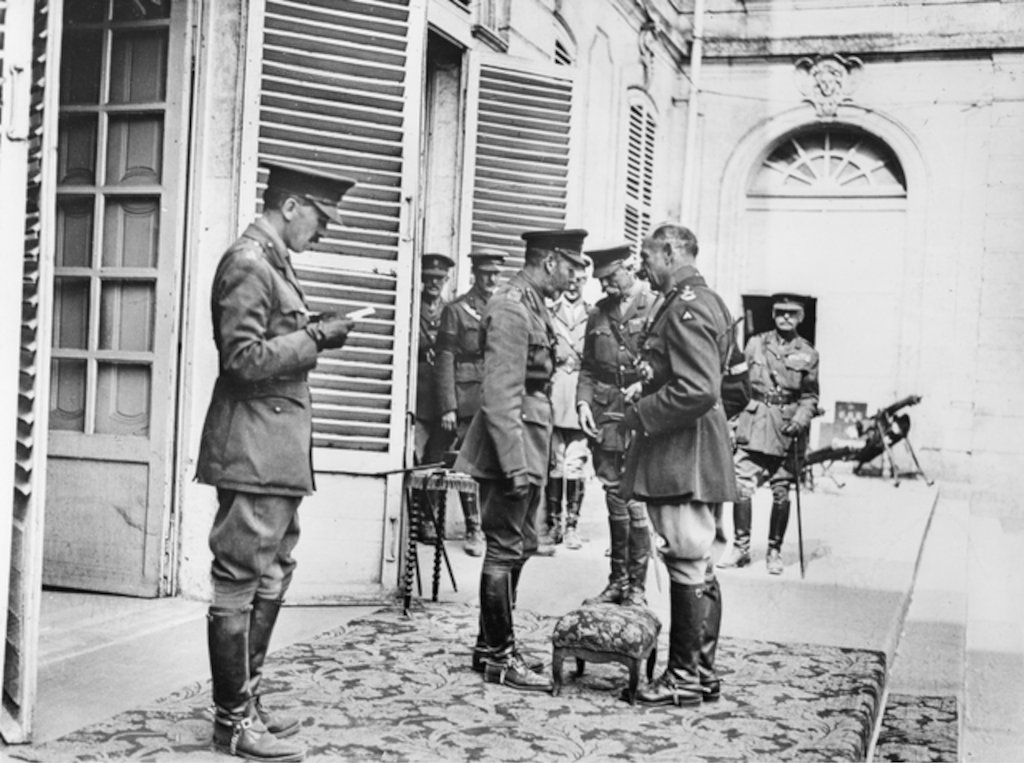
Monash receiving his KCB from George V on 12 August 1918.
[12]
In late September 1918 it was becoming clear the war would end soon with an Allied victory. It was also becoming clear that Australia's
involvement would be ending even sooner.
Monash orders attack on Montbrehain
With the Americans delayed by a day, British Fourth Army Commander Rawlinson requested that Monash hold the line one additional day
with the exhausted 2nd Division. Monash decided to use that day to capture the village of Montbrehain using the 6th Brigade.[7] page 278 To reinforce the depleted 6th Monash added the Australian 2nd Pioneer
Battalion in an infantry role instead of the Pioneer's usual engineering role. The attack on Montbrehain was hastily planned for 5
October 1918.
Will's 23rd Battalion was assigned to protect the left flank of the two 6th Brigade battalions that were to take Montbrehain
directly (the 24th and 21st, with additional support from the 2nd Pioneer Battalion). The 23rd fought their way towards a position just
to the north-west of Montbrehain starting on 4 October. They were to hold that position and protect the left flank until relieved by
the incoming American 30th Division on 6 October.[8]
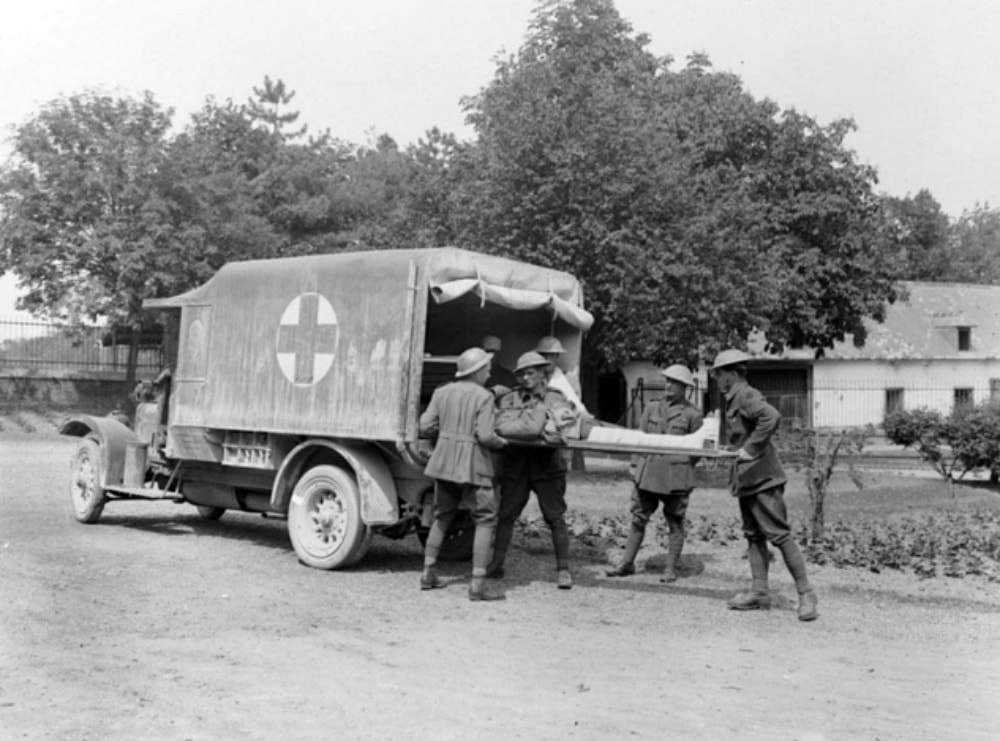
Unidentified soldiers, probably members of the 2nd Division Army Medical Corps (5th Field Ambulance), unloading serious cases from
a motor ambulance car for removal to the Australian Dressing Room at Templeux-Le-Guérard.
[A high-resolution copy of this photo is available at
the Australian War Memorial archive.]
On 4 October, when moving into their position, the 23rd Battalion encountered intense machine gun fire, and at one point withdrew so
Allied artillery could place a barrage on a shallow German trench system near the road between Montbrehain and Beaurevoir.[8] At an unknown time during these operations William was seriously wounded.
On 5 October William was evacuated back to the 5th Australian Field Ambulance station at 2nd Division HQ just outside the village of
Templeux-le-Guérard.[4] That was a distance of about 16 km. 5th Ambulance reports from the
previous day indicate the journey took about four to five hours.[10] William died
of his wounds the same day. He was buried at a small military cemetery just outside Templeux-le-Guérard.
Based on when William was transported I would guess he was wounded late on 4 October, possibly after dark,
and was evacuated via ambulance very early the following morning.
In the last 100 years there have been many analyses of what would be the final infantry engagement for Australians in WWI. Charles
Bean, Australia's official war correspondent who observed the battle and had closely followed Australian units throughout the war,
wrote the following in the Official History of Australia in the War of 1914–1918.
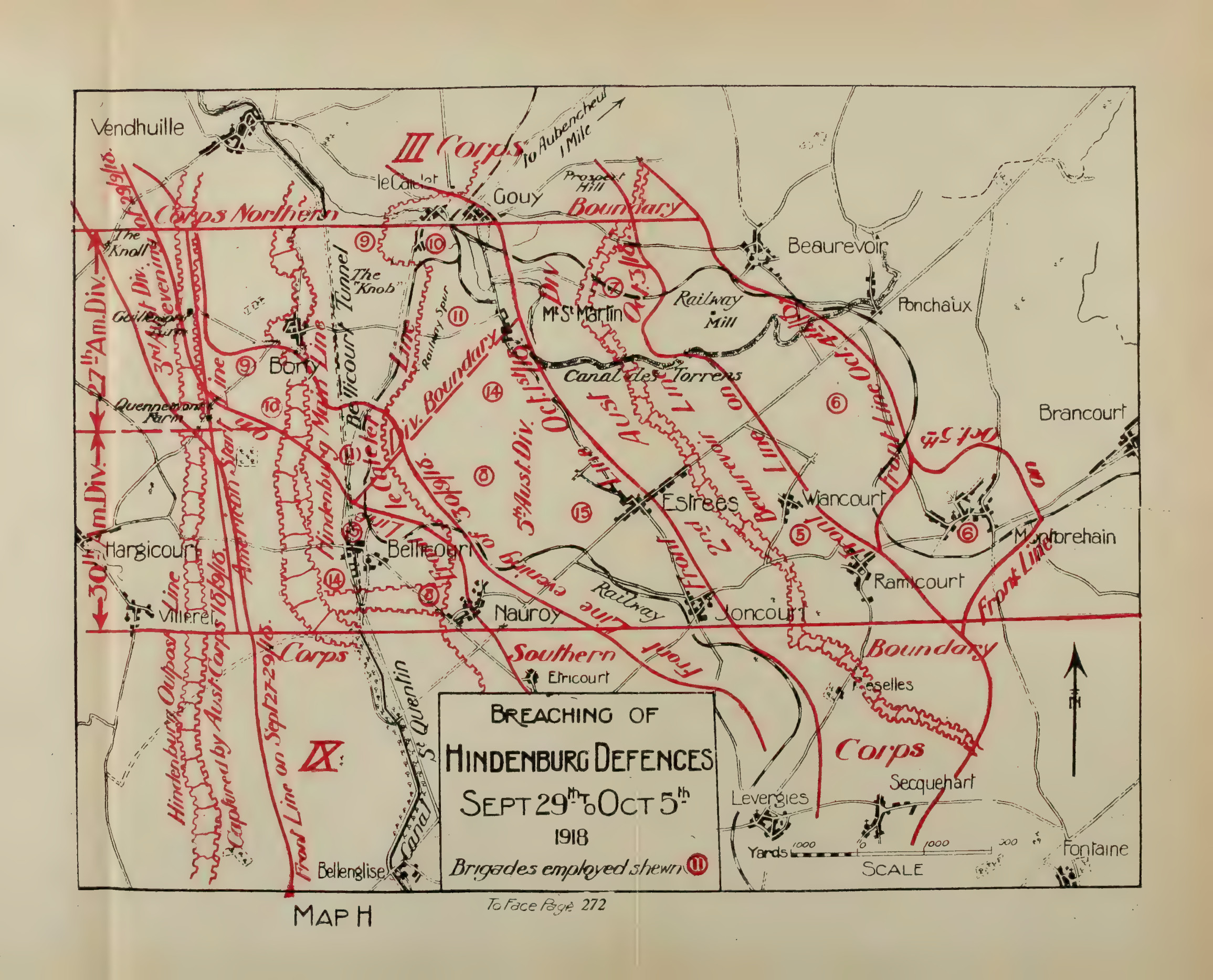
Monash's post-war publication
The Australian Victories in France in 1918 showing the salient he created with the attack on
Montbrehain.
[7]
The taking of Montbrehain was the last and one of the most brilliant actions of Australian infantry in the First World War. Yet--as
with many local attacks--it is difficult to feel that it was wisely undertaken; it seemed, rather, devised to make some use of these
troops before withdrawing them in accordance with the Prime Minister's demand. They gave the enemy a sharp knock and took nearly 400
prisoners; and their line now stood out egg-shaped a mile ahead of the general front. But they did not capture one hostile
[artillery] battery or "let the cavalry through," [allow cavalry to exploit a breach in the line to attack enemy rear positions] nor
were they intended to do so. The action cost some 30 officers and 400 men. Ten officers, among them some of the best leaders in the
6th Brigade, and many of the best N.C.O's and men, had been killed. At such cost, at this stage of the war, Australian troops could
have achieved far-reaching results in any general attack.[8]
By "egg-shaped", Bean is referring to the strategically undesirable salient (or bulge) that Monash's Montbrehain action created in the line. William was protecting the left flank of this
salient when he was wounded.
In his contemporaneous diary of the war, Bean was more blunt:
Our troops have come out of the line, after the last stupid wicked fight at Montbrehain where Mahoney of the 24th and other grand men
fell for no reason except to increase the reputation of a division and of a general [Monash].[9]
Next of Kin
I haven't been able to find clear documentation on when Rachel was notified her son had died. The time between
an Australian casualty and NoK notification seemed to vary depending on rank and the number of casualties in the action. Reports of the
battle appeared in Australian newspapers on 8 October so Rachel likely received a telegram or hand-delivered letter (transcribed from a
telegram) within two weeks.
As was standard at the time, William had completed and signed his Will while he was in Broadmeadows recruit camp the previous
year.
In the event of my death I give the whole of my property and effects to my Mother Mrs Rachel Griffin.
Ella Grove
Chelsea
Victoria[4]
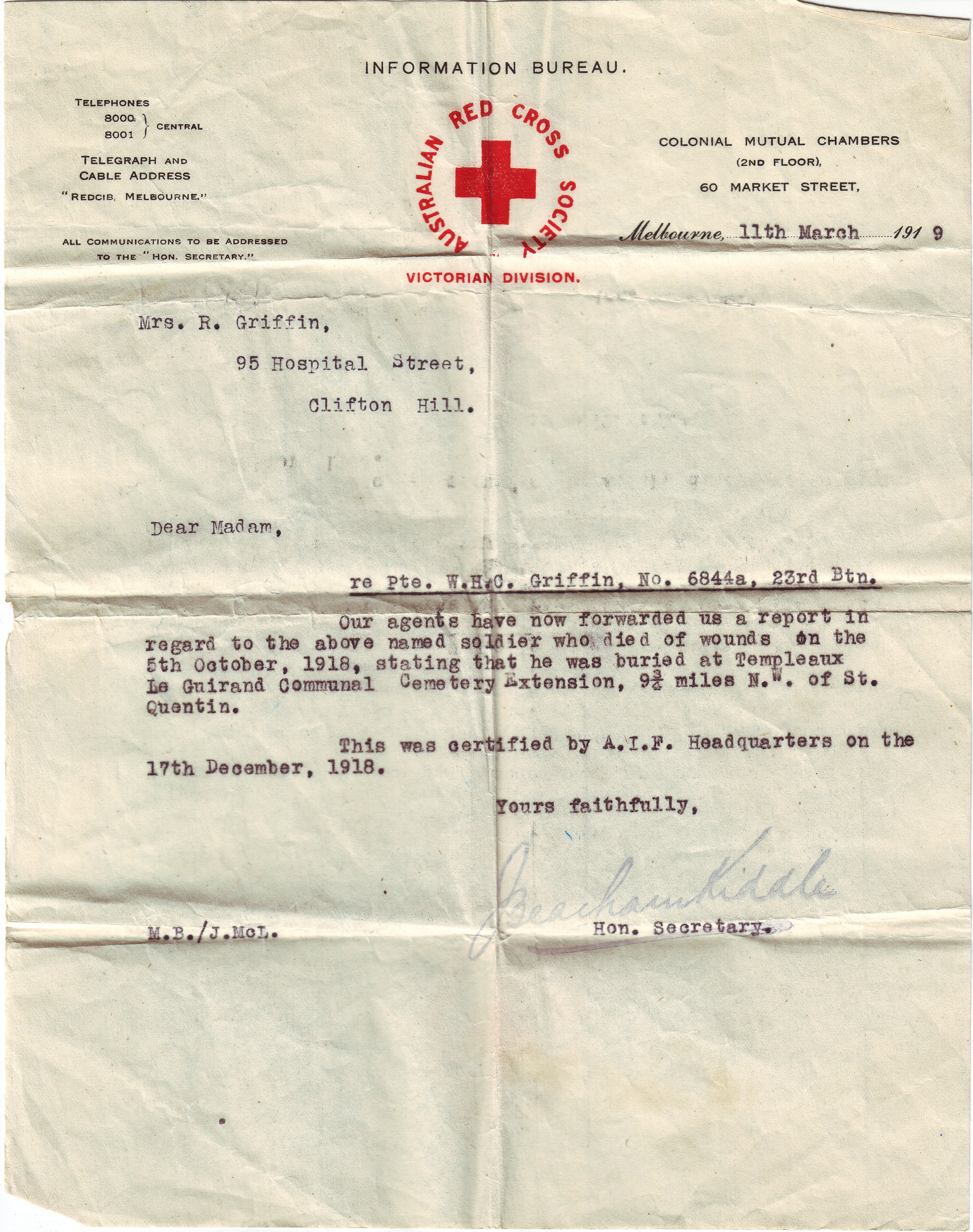
NOK report from the Red Cross. Scan provided by Bev Smith.
As the months and years ticked by after Will's death, Rachel and William Sr would receive various letters and packages from the
Australian Military regarding Will's service and death. Rachel was living in Clifton Hill and William Sr had moved to a cottage in
Warburton at the Seventh Day Adventist colony.[4] George Stap arrived back from France on 1
February 1919 on the Argyllshire and resumed living with Rachel.
In March 1919 Rachel received a reply from the Red Cross answering her query about the location of Will's grave. The Red Cross
provided families fairly detailed information, including injuries, locations of soldiers undergoing medical treatment, and in the case
of fatalities as much information as could be gathered about the soldier's service and how they died.
Will's letter is lacking details about his service, possibly because the war had ended and his fellow 23rd Battalion soldiers were
demobilising. The Honorable Secretary of the Victorian Red Cross, J. Beacham Kiddle, signed his correspondence with a rubber stamp due
to the impracticability of hand-signing the thousands of these letters that were sent out to next-of-kin.
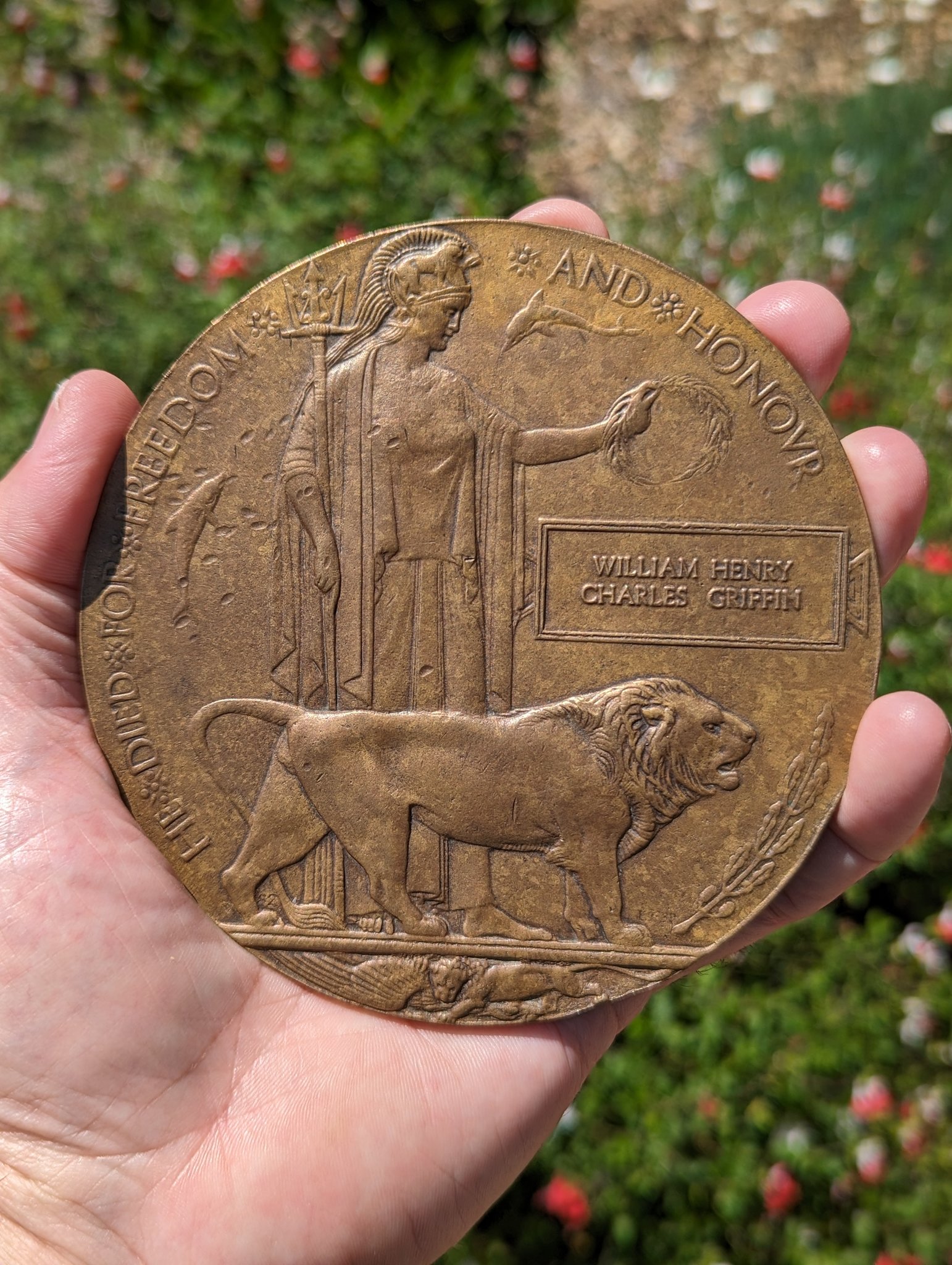
Memorial Plaque for Will's next of kin.
Rachel signed for this on 19 April 1923.
[4] These objects were informally known as a
Dead Man's Penny, or Widow's Penny.
I would guess this object was not welcome in Rachel's home. It was found 100 years after William's death
in a pile of scrap metal in Newcastle, New South Wales. The finder, Sabina Dryden of Lucky's Scrap Metals, kindly tracked down a relative of Will's and mailed the plaquette.
Rachel received Will's personal belongings in a mailed parcel in July 1919.[4] They
were:
- Letters
- Wrist watch (broken) and strap
- Disc
- Pocket knife
- 25 foreign coins
- Wallet
- Photos
- Cards
- 2 metal rings
- Purse
- Religious medallion
- Metal chain
- 2 keys
Also in July 1919 three photos of Will's grave were mailed along with a booklet explaining the care the authorities were taking with
the graves of Australian fatalities. A memorial scroll was mailed to William Sr that month too. Will was awarded two medals
posthumously. The British War Medal was received by William Sr in May 1921. William Sr returned the medal with a note requesting it
instead be sent to Rachel in Clifton Hill.[4]
In November 1922 a Memorial Plaque was shipped to Rachel. She signed the receipt for it on 19 April 1923. The next-of-kin of all
British Commonwealth fatalities received this very large bronze "plaquette".[4]
Rachel received Will's Victory Medal in May 1923.[4] The Victory Medal and British War
Medal were awarded to all members of the AIF who served in France.
Aftermath
I suspect Rachel was rightfully inconsolable when she was notified of Will's death, and (perhaps less
justifiably) furious with Evelina who was 16 when her older brother pressured her into forging their mother's consent.
Rachel and Will's siblings placed notices in the 'In Memoriam, on active service' section of Family Notices in The Age on 5
October for several years. In 1919:
GRIFFIN. — In sad and loving memory of my dear brother, Will, who died of wounds 5th October, 1918.
We are thinking of you to-day, dear Will,
We are thinking of the past;
We picture you in memory
Just as we saw you last.
No more your welcome footsteps
Will tread on our dwelling floor;
No more we'll watch your coming.
As we did in days of yore.
Fond remembrance of the past,
Will always bring regret,
Until our lives will cease to be
We never will forget.
—Inserted by his loving sisters and brother-in-law, Lena, Dolly, Tom Chesswas, 97 Hodgkinson-street, Clifton Hill.
Though Evelina was single she was no longer living with her mother, but rather with her sister and brother-in-law, Florence ("Doll")
and Thomas Chesswas.
Rachel also placed a notice in 1919.
GRIFFIN.--In sad and loving memory of my dear son, Private W. H. C. Griffin, C Company, 23 Battalion, killed in action on 5th
October, 1918 at Mont. St. Quentin.
When alone in my grief the bitter tears flow,
There comes a sweet vision of not long ago;
Like in a dream he stands by my side,
And whispers in sweet words, Don't cry.
Could I, his mother, have clasped his hand,
The son I loved so well;
I loved him in life, he is dear to me still;
But in grief I must bow to God's holy will;
My sorrow is great, my loss hard to bear,
But angels will tend my dear Willie with care.
--Inserted by his loving mother, Mrs. W. R. Griffin, Chelsea.
It's notable that family members were unaware Will had been killed as part of the AIF attack at Montbrehain. Lack of accurate
information from the Australian Military was no doubt responsible for this confusion. The family may have seen that many of the other
notices posted on 5 October over the following years were for AIF soldiers killed at Montbrehain in 1918.
Evelina
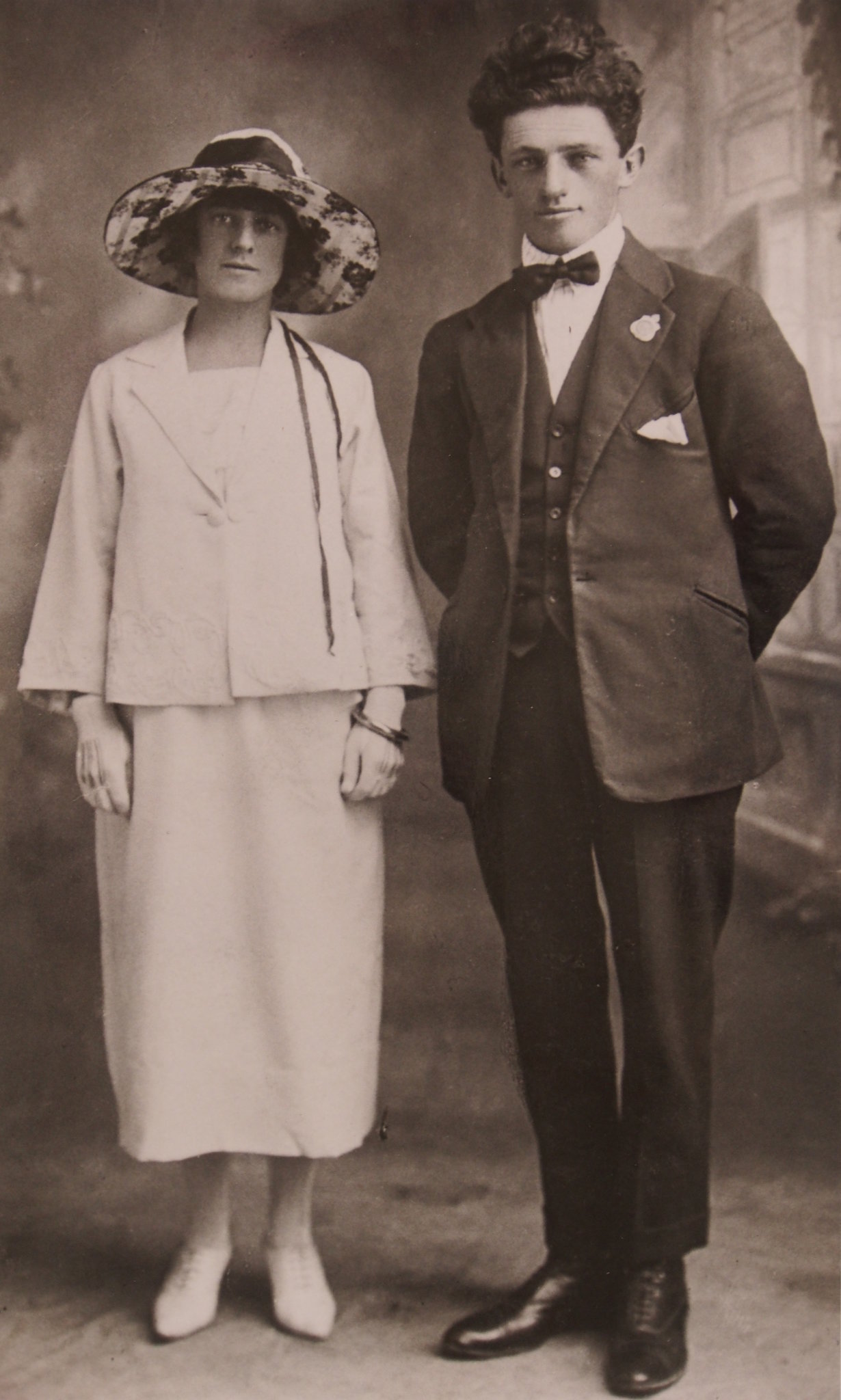
Wedding portrait of Evelina Griffin and Eric Phillips, December 1921.
Evelina would later marry an AIF veteran of the Great War. Eric William Phillips had been discharged from Langwarrin recruit camp in
1917 for medical and misconduct reasons.[5] If he had not been discharged he would have been
assigned to the 23rd Battalion as part of the 19th reinforcements, and if he had survived through to May 1918, Eric would likely have
met Will.
Due to multiple enlistments, extensive medical reports (Eric arrived at Langwarrin with gonorrhea, which was
"cured" by the time he was discharged), and several disciplinary actions, Eric's AIF record is one of the longest I've seen at 74 pages.
When the AIF was scrambling for recruits in August 1917 they allowed Eric to re-enlist, though they were aware of his earlier
misconduct and medical discharge from recruit camp. Eric was assigned to the 21st Battalion. He was transported to Egypt on the same
Nestor sailing as Will, and like Will, his battalion was part of the 6th Brigade attack on Montbrehain.[5] Eric would have been just outside Montbrehain on 4 October 1918, a few kilometers south of the 23rd Battalion
when Will was wounded.
I don't know if Will and Eric met. Their respective battalions were both part of the 6th Brigade, and they
did sail to Egypt on the same transport, so it's possible.
Evelina married Eric 21 December 1921 in Collingwood. Their son Neville was born in January 1923. Tragically Neville died in an
accident 15 November 1924. Eric, who had ongoing kidney disease likely caused by his earlier gonorrhea infection, died on 20 October
1927 of kidney failure. Evelina was 26 years old and had lost both her son and husband.
Family oral history records that Evelina did not get along with her mother, Rachel, and would not have been
happy or welcome living at Rachel and George's house in Ormond.[1]
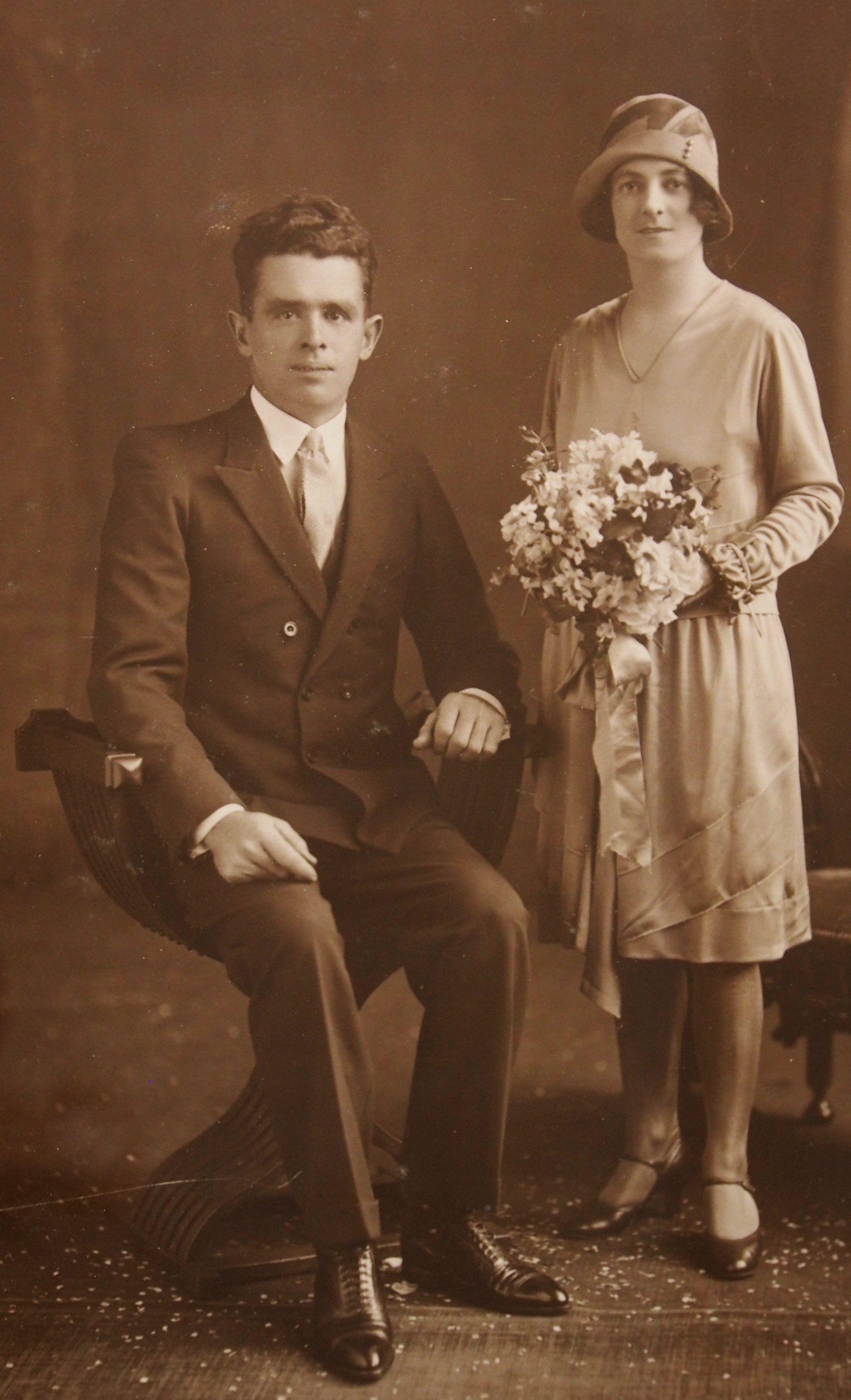
Wedding portrait of Norman Campbell and Evelina Phillips, July 1929.
Evelina met Norman McLean Campbell in 1928. She was living in
Meeniyan, a small town in Gippsland, with Eric's father and at least one of Eric's brothers.[1] Norman had travelled down from Lockhart in New South Wales and was visiting his cousin who also lived in
Meeniyan.
Norman and Evelina were my paternal
grandparents.
Notes
- [1] Electoral rolls archived at Ancestry
- [2] GENERAL NEWS (1897, March 5). The
Inquirer and Commercial News (Perth, WA : 1855 - 1901), li. 9.
- [3] George Stap's AIF
record
- [4] W.H.C. Griffin's 2nd AIF record, successful enlistment
- [5] Eric William
Phillip's AIF record.
- [6] W.H.C. Griffin's 1st AIF record, failed enlistment
- [7] Australian Victories
in France in 1918, John Monash
- [8] Official History of Australia in the War of 1914–1918, Volume VI – The Australian Imperial
Force in France during the Allied Offensive, 1918, Chapter XX –
The Hindenburg Line, C.E.W Bean, 1942
- [9] German Anzacs and the First
World War, John Frank Williams, 2003.
- [10] 5th Australian Field Ambulance diary, October 1918.
- [11] Monash knighted, Australian War
Memorial collection.
- [12] Monash and Hughes, Australian War
Memorial collection.
Acknowledgments
The following people and organisations provided information for this page:
Additional images
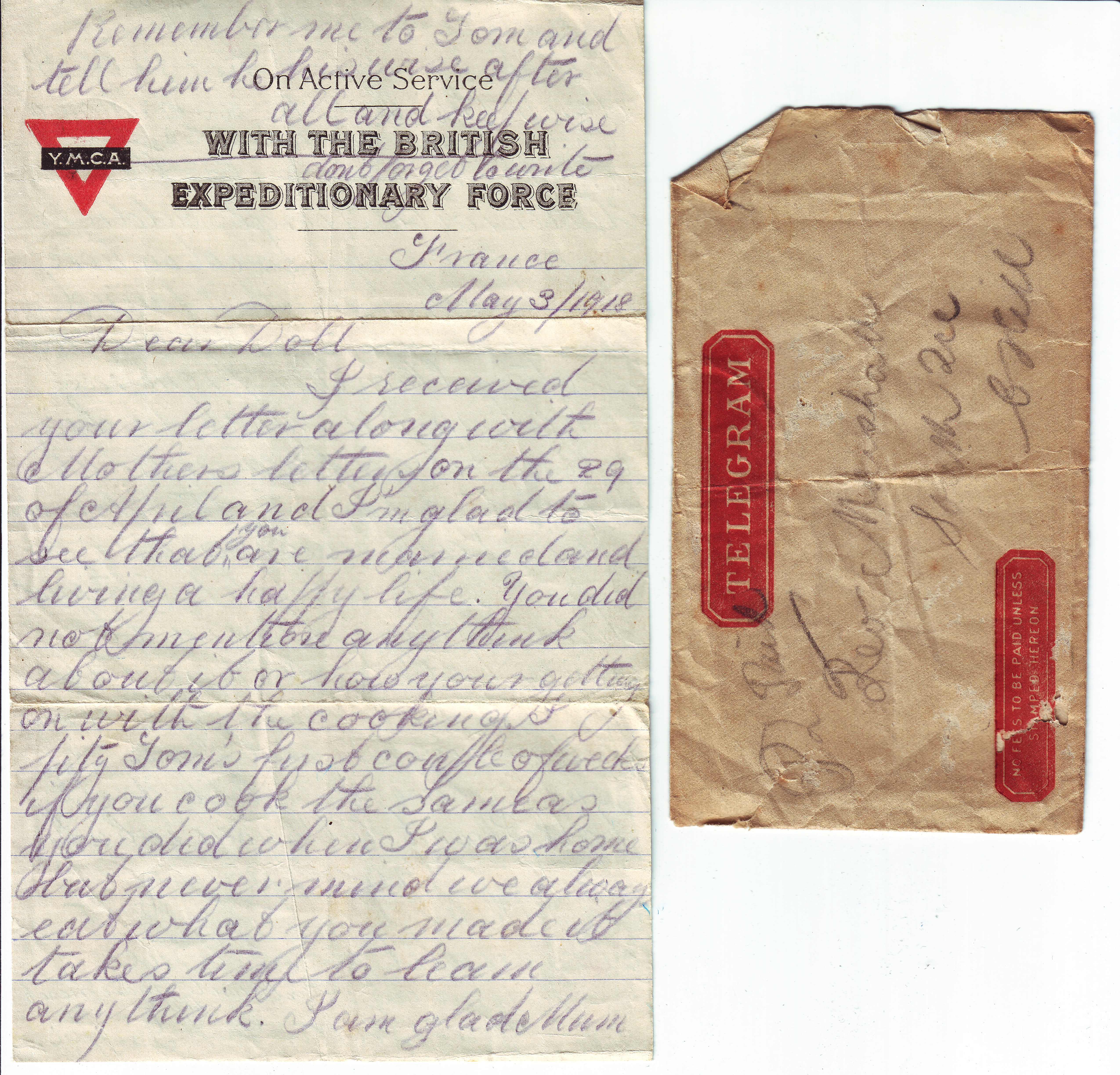
Page 1 of Will's letter to his sister Doll (Florence May Griffin). Written on 3 May 1918 after Will had joined the 23rd
Battalion in France, but before his first combat.
|
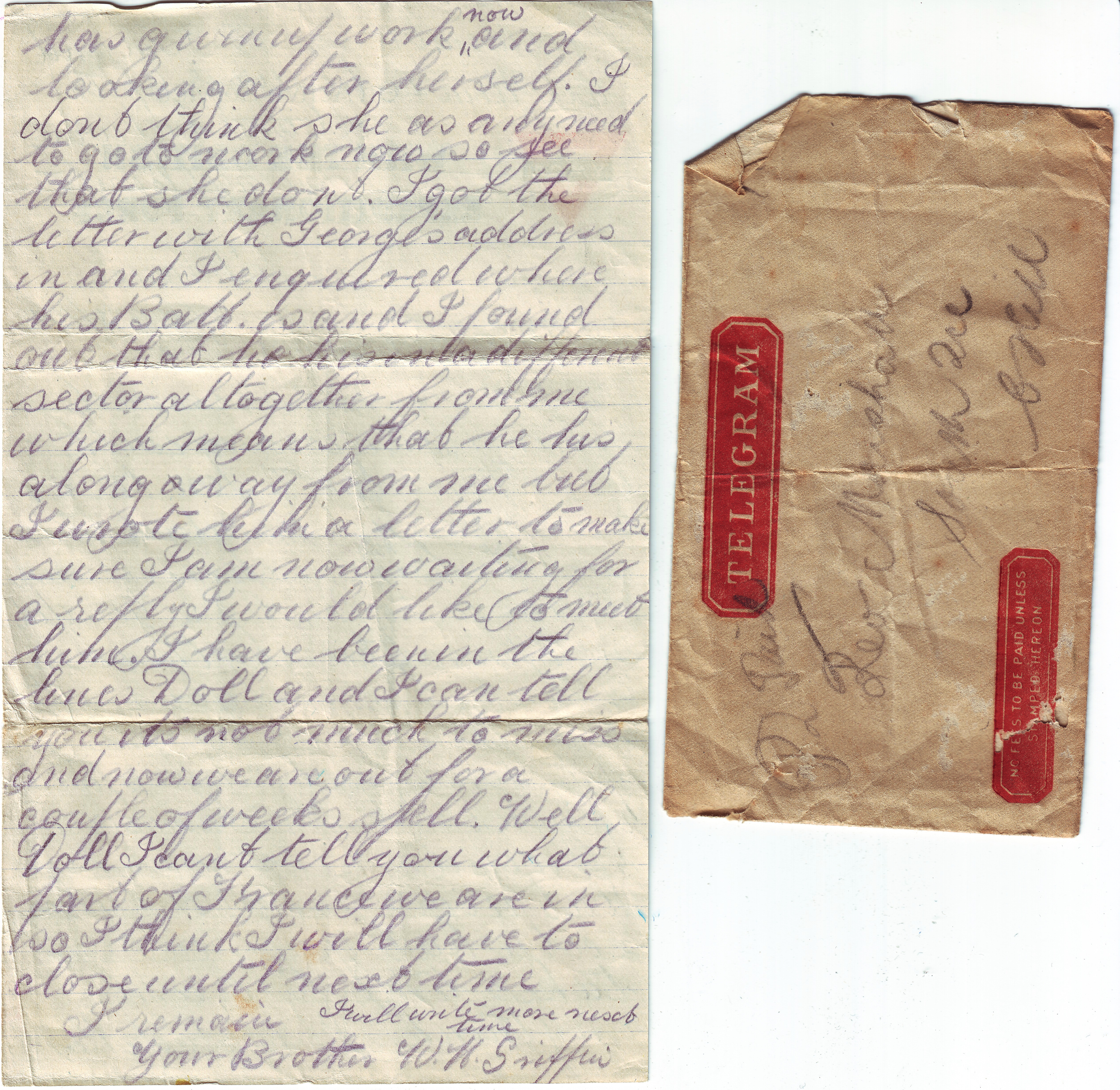
Overleaf, page 2 of Will's letter to his sister Doll.
Scan courtesy of Bev Smith.
|
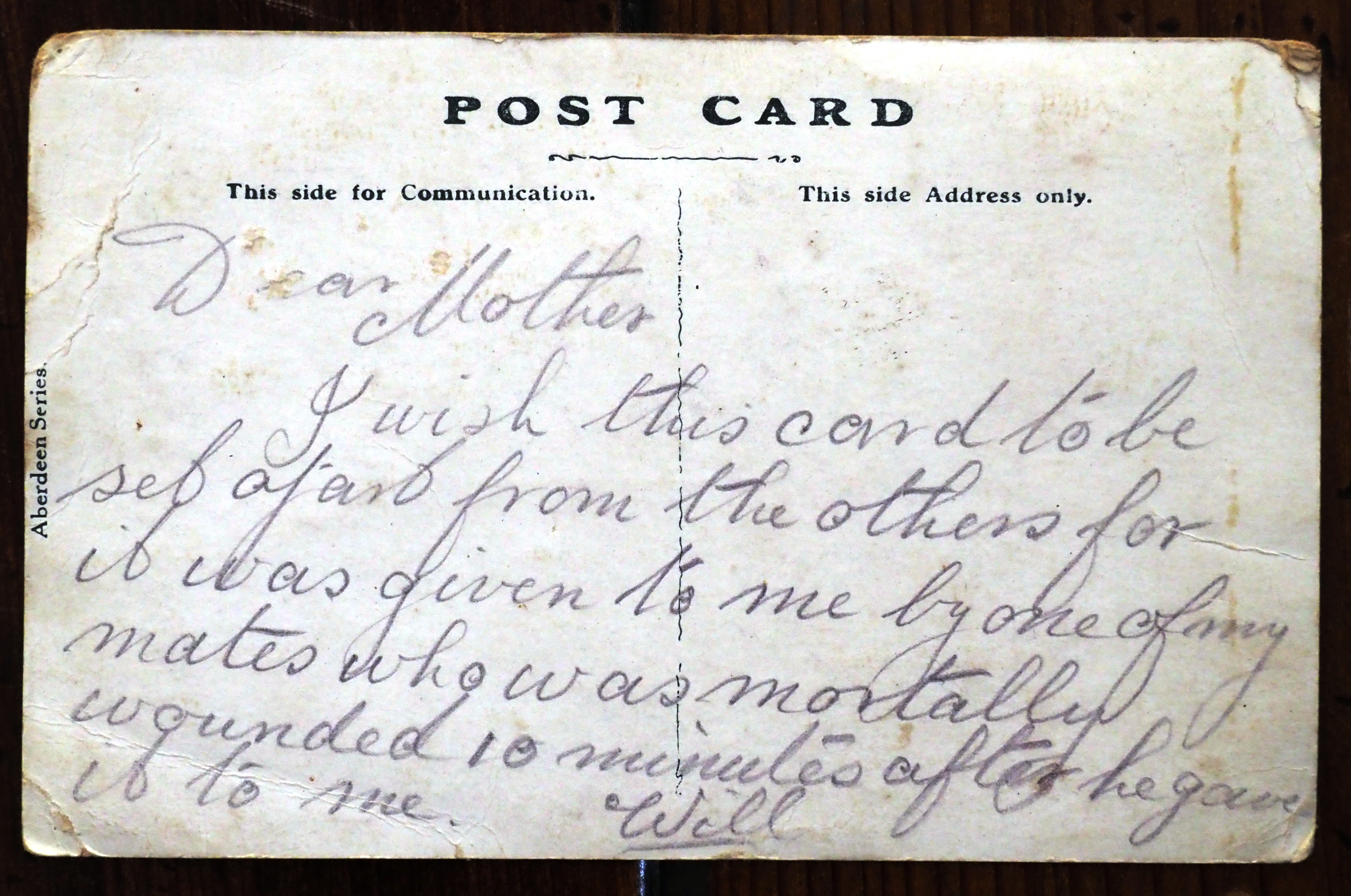
Back side of undated postcard from Will to his mother, Rachel.
Dear Mother,
I wish this card to be set apart from the others for it was given to me by one of my mates who was mortally wounded 10
minutes after he gave it to me. Will
|
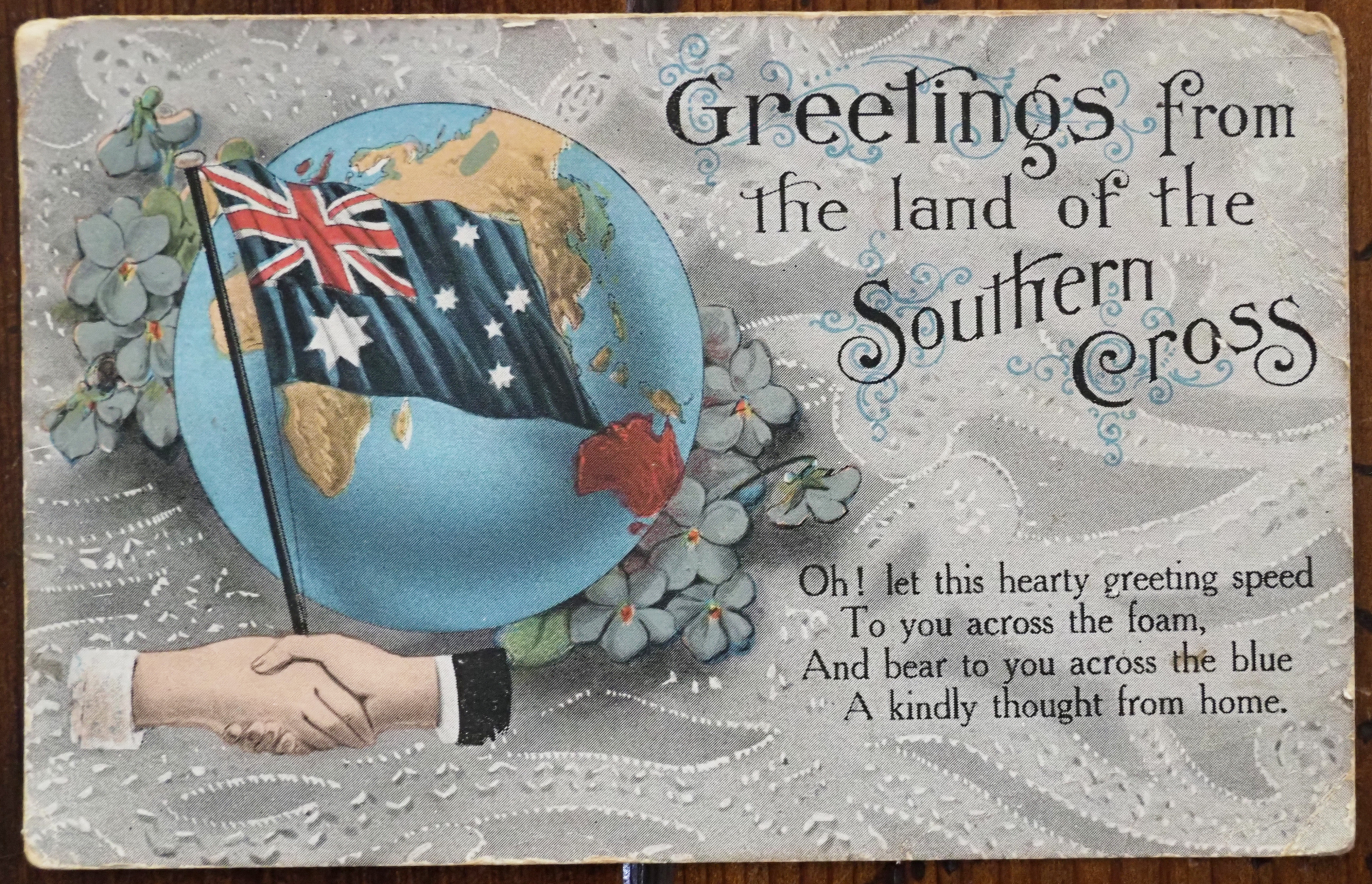
Front side of the same undated postcard from Will to his mother, Rachel.
Scan courtesy of my cousin Fiona.
I have been struggling to understand why Will thought it was appropriate that his mother should
ever see what he has written on this postcard.
|
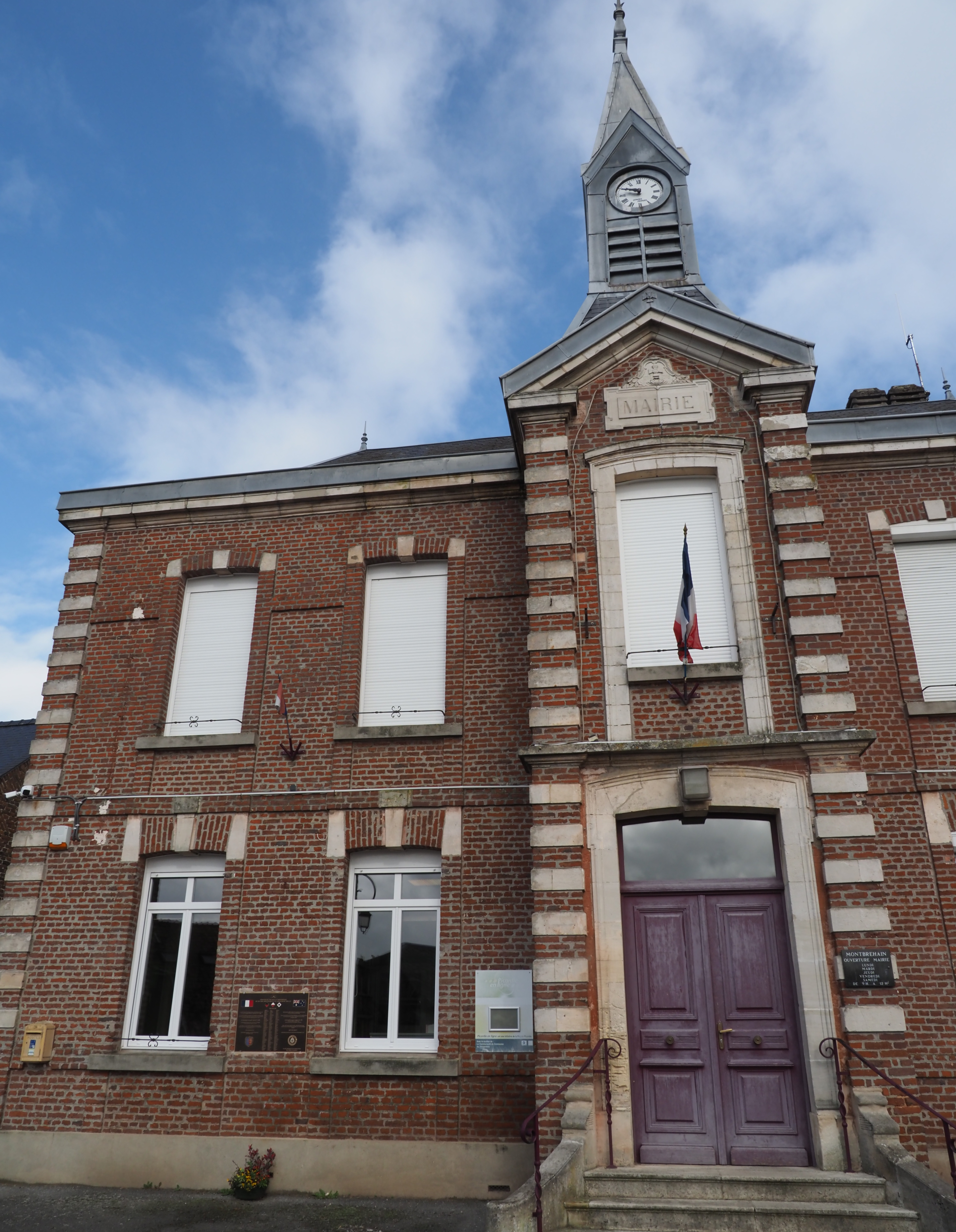
The Mairie (town hall) in Montbrehain has a small plaque memorialising the AIF fatalities. It's visible between the two
windows on the lower left.
|
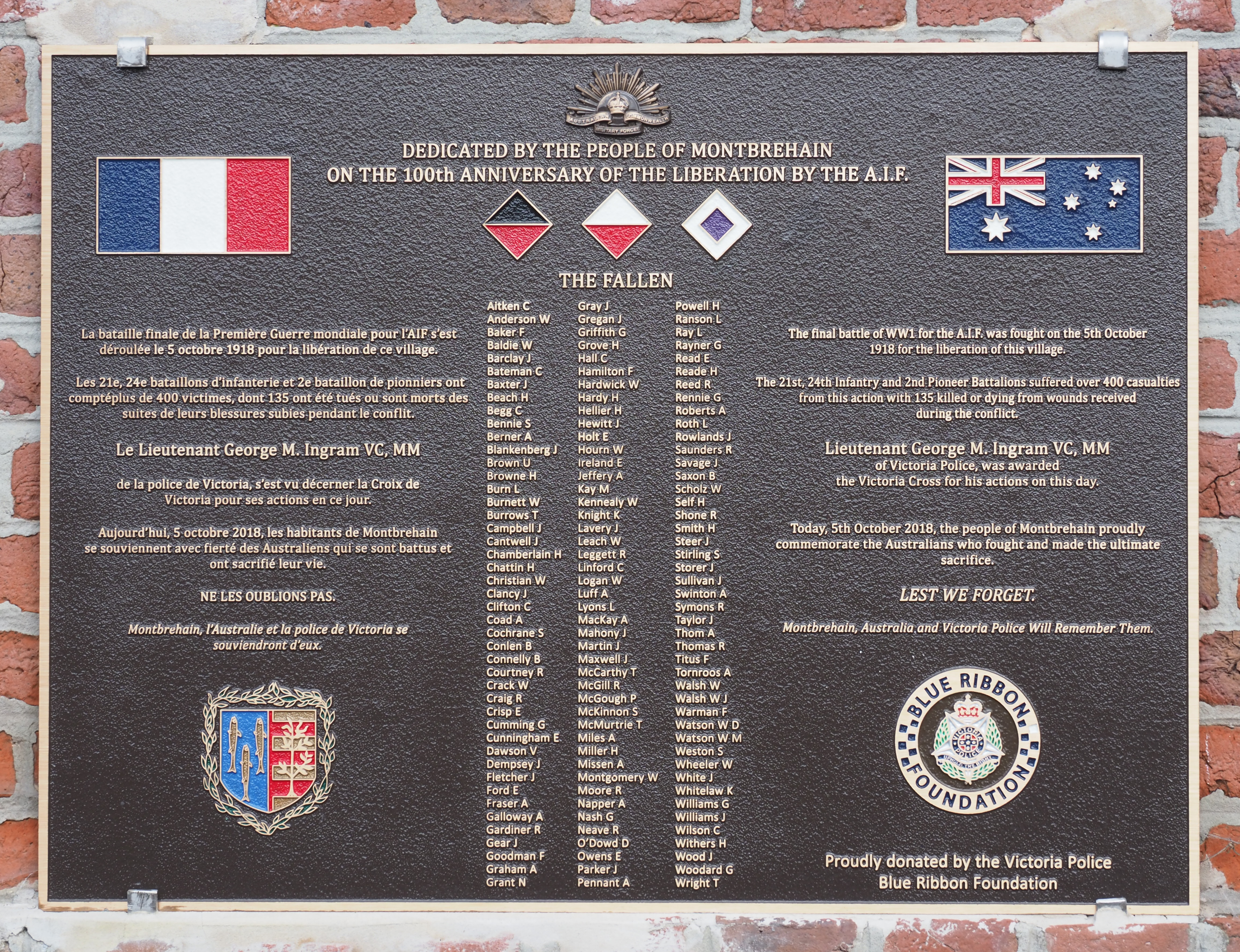
Close-up of the memorial plaque that was dedicated on 5 October 2018, exactly 100 years after the Battle of Montbrehain. Note
that even though all battalions of the 6th Brigade were involved in combat on that day, fatalities from Will's 23rd and the
22nd Battalion are not mentioned. The 22nd was also involved in heavy combat protecting the left flank of the main assault on
Montbrehain. Without the actions of the 22nd and 23rd the list on this plaque would have been much longer.
|
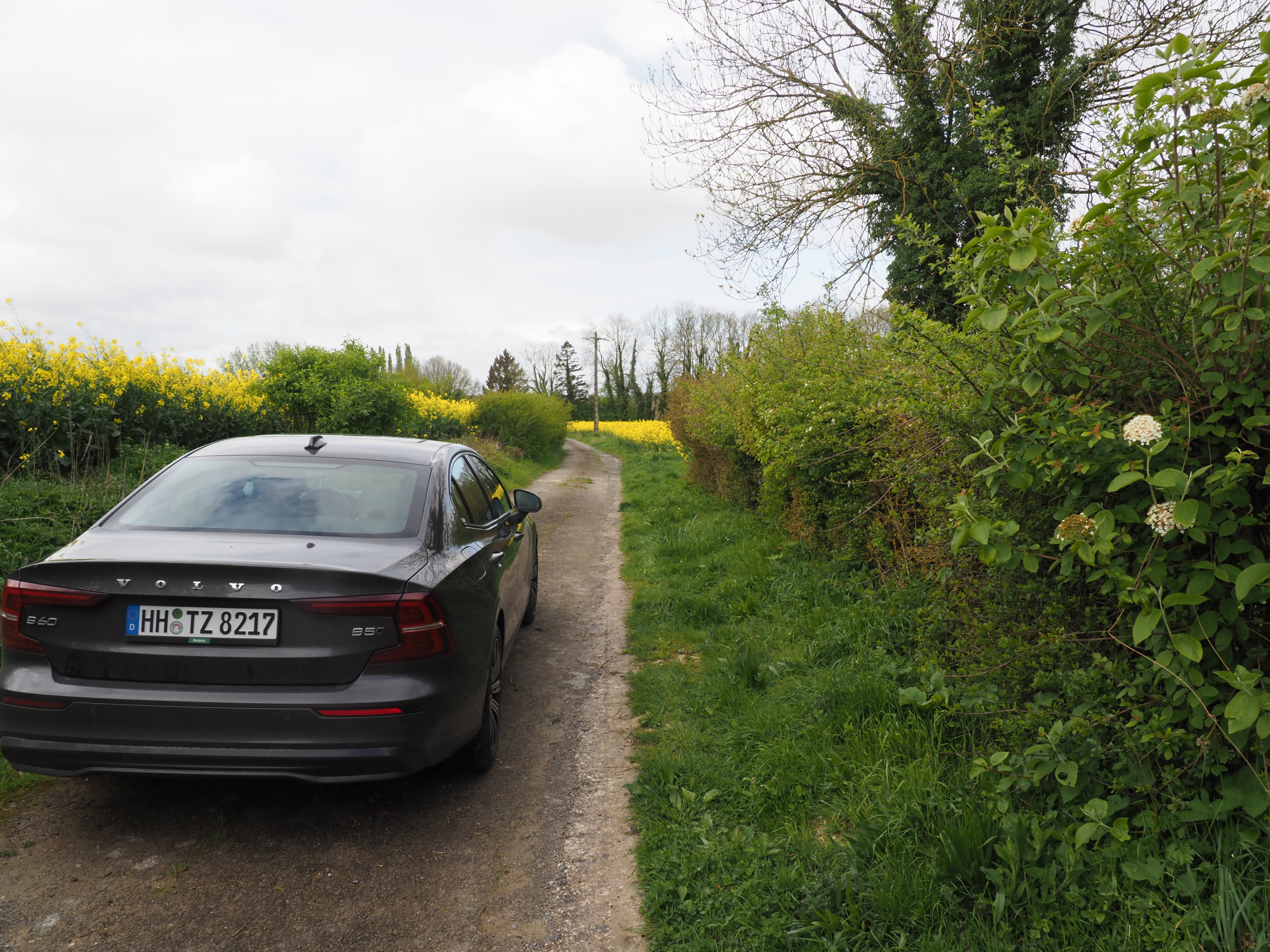
|
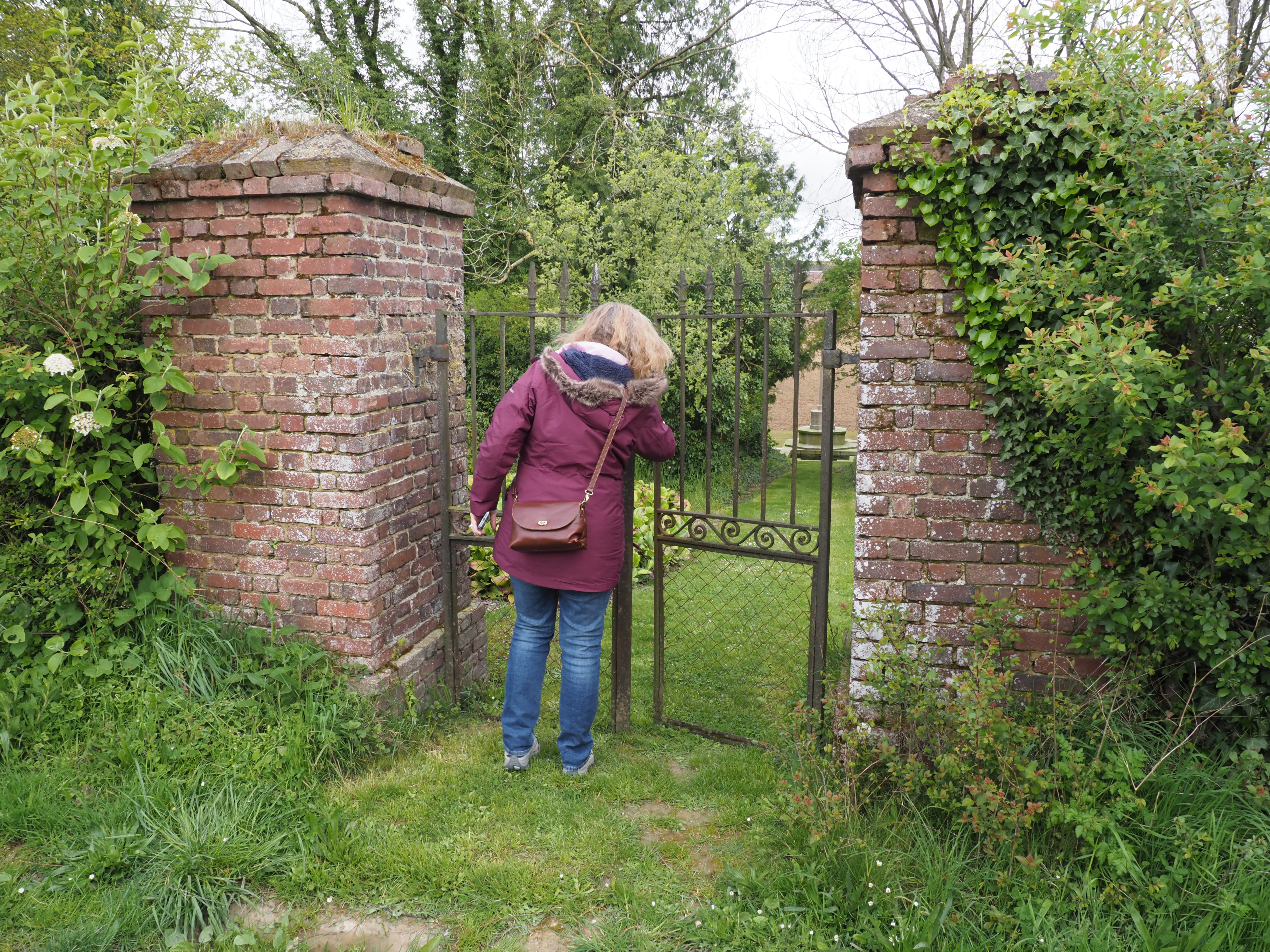
The gate to the cemetery. The portion of the cemetery closest to the laneway has (some recent) graves of civilians.
|
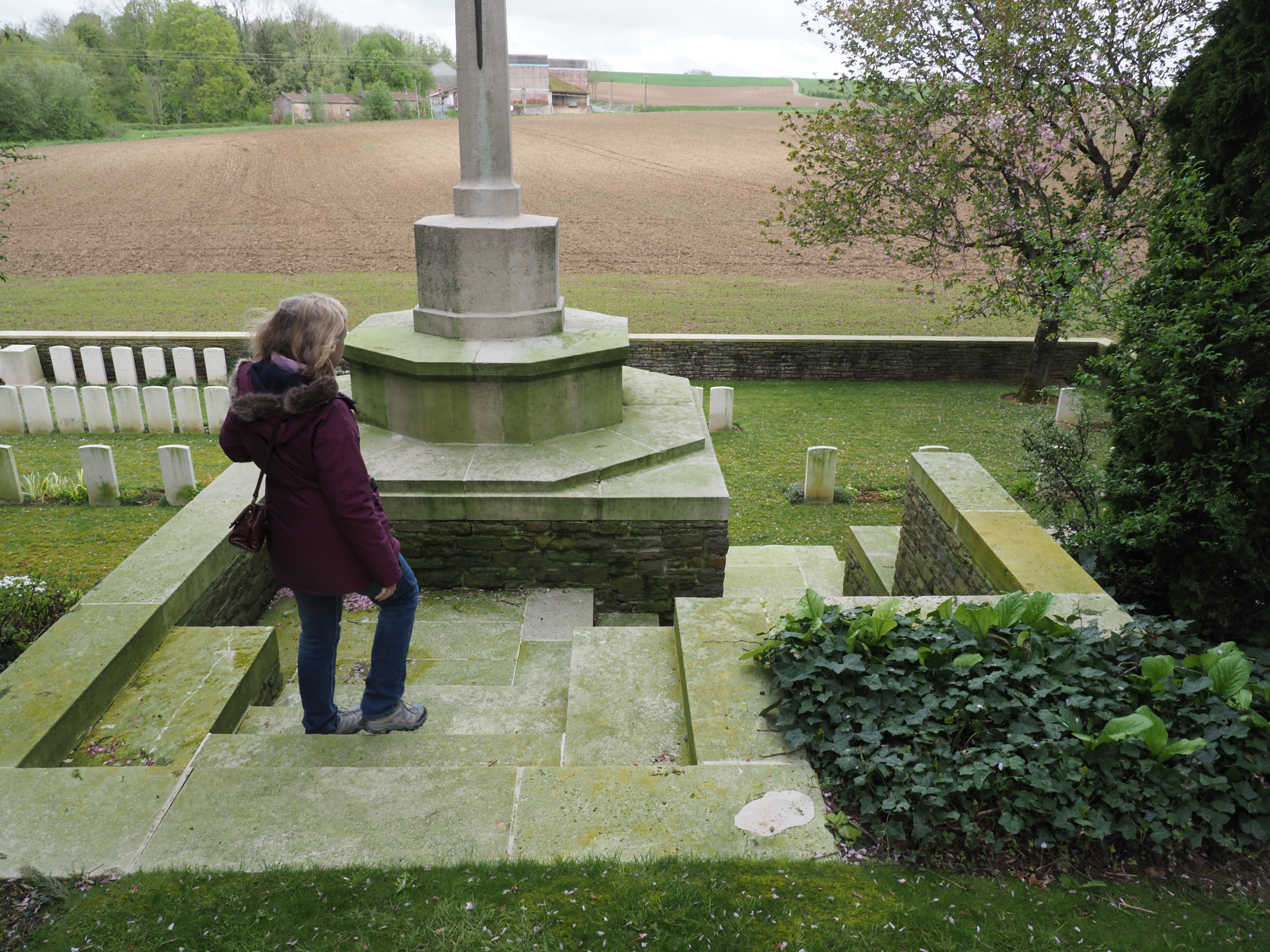
A grassy path leads down to the small military section of the cemetery. The cemetery is located next to a field which was
ploughed when I was there in April 2024.
There is a large metal plaque near the bottom of the
steps that briefly describes the burials and says "This cemetery was constructed and is maintained by the Commonwealth War Graves Commission".
|
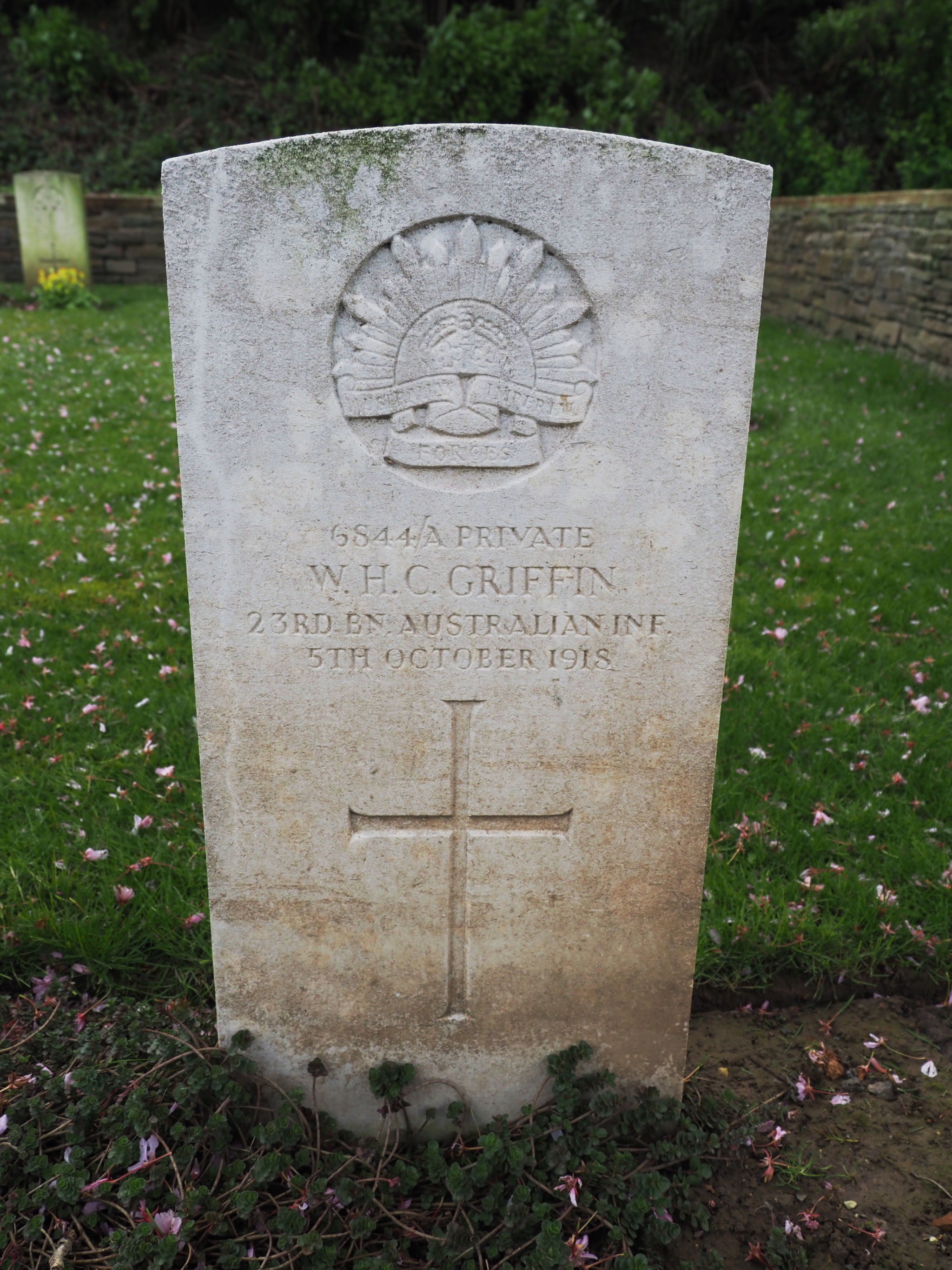
Will's grave. The headstone reads:
6844/A PRIVATE
W.H.C. GRIFFIN
23RD BN AUSTRALIAN INF.
5TH OCTOBER 1918
|